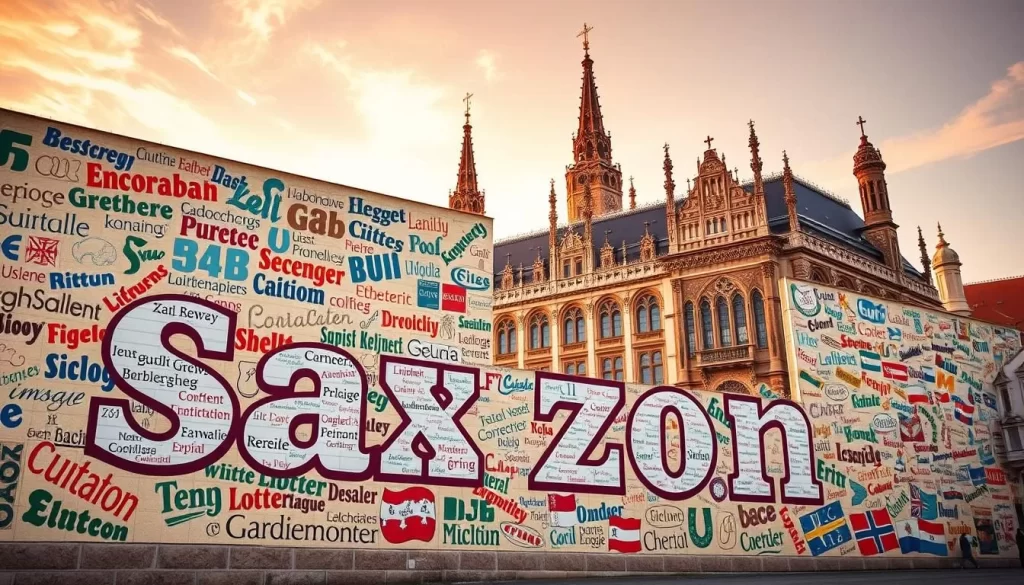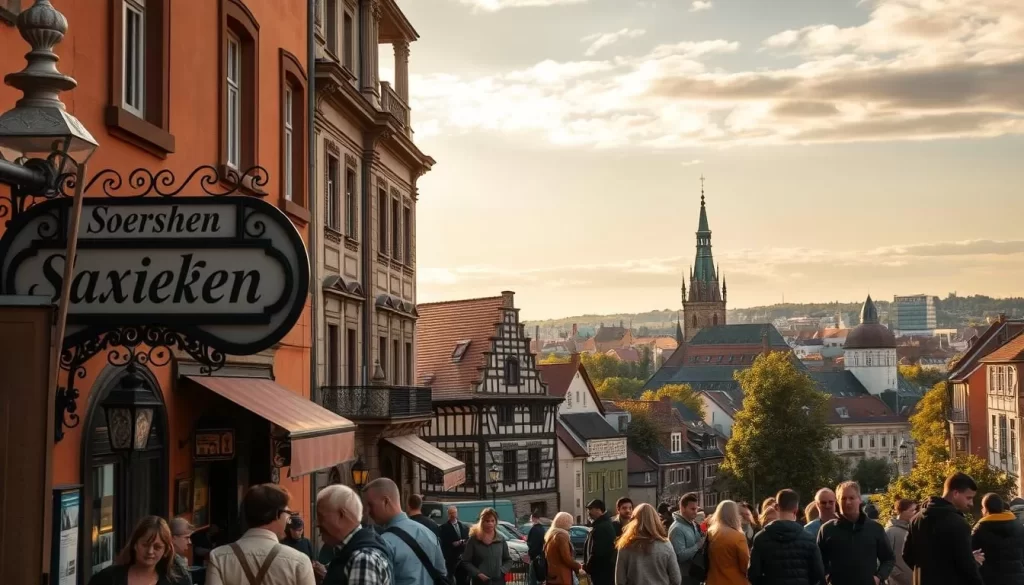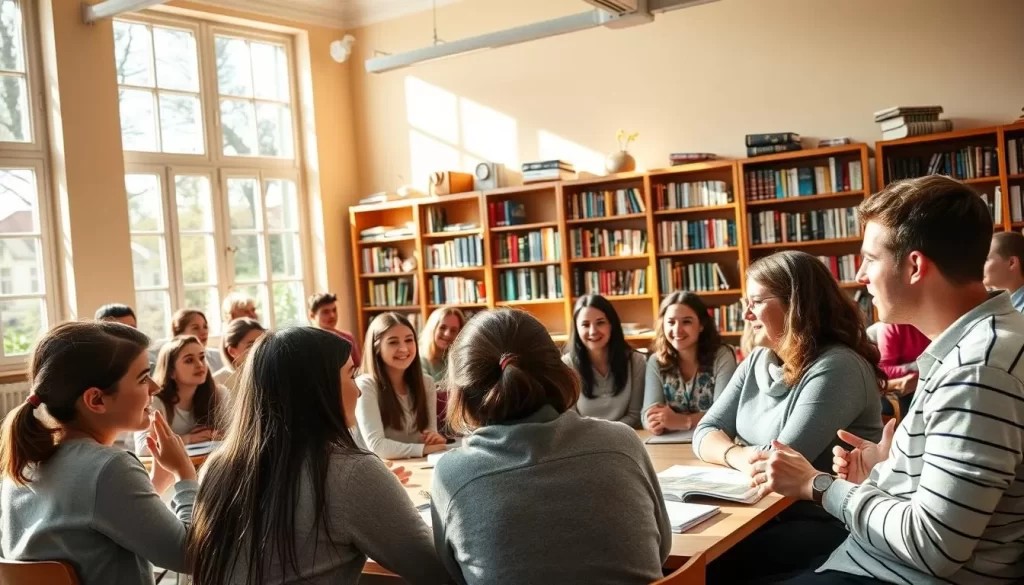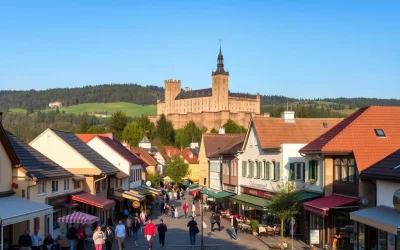✓ Accommodations✓ Flights✓ Rental Cars
When you think of this country, the german language likely comes to mind. It’s the official language, spoken by over 95% of the population. This linguistic unity plays a key role in shaping culture, governance, and daily life.
Beyond its borders, the language spoken here is also influential across Europe. Many residents are multilingual, adding to the vibrant cultural tapestry. Whether you’re exploring bustling cities or quiet towns, you’ll find a strong connection to the german language.
This section sets the stage for a deeper dive into how language shapes identity in this region. Stay tuned to learn more about dialects, statistics, and the unique linguistic heritage that defines this part of the world.
Introduction to Saxony’s Linguistic Heritage
Exploring the linguistic roots of this region reveals a fascinating blend of tradition and modernity. The way people communicate here is deeply tied to its history and cultural evolution. From ancient dialects to modern influences, the linguistic landscape is vibrant and dynamic.

Overview of Official Languages and Dialects
German is the primary language, but regional dialects like Upper and Lower Sorbian add unique flavors. These dialects are more than just ways of speaking—they’re a link to the past. They shape the identity of communities and reflect the region’s rich heritage.
Low German, another historical dialect, also plays a significant role. It’s a reminder of how language evolves over time, adapting to new influences while preserving its roots. This blend of old and new creates a linguistic tapestry that’s both diverse and cohesive.
Influences of Immigrant and Minority Languages
Immigrant communities bring their own languages, enriching the cultural fabric. Turkish, Russian, and other minority languages are now part of everyday life in major cities. This diversity fosters a sense of inclusion and broadens the region’s cultural horizons.
Language diversity isn’t just about communication—it’s about connection. It allows people to share their stories, traditions, and experiences. This exchange of ideas strengthens the community and highlights the value of cultural expression.
Whether you’re a visitor or a resident, you’ll notice how language shapes the way people interact. It’s a testament to the region’s ability to embrace change while honoring its past. This linguistic heritage is a key part of what makes this area so unique.
Historical Evolution of Language Policies in Saxony
Language policies here have evolved significantly over centuries. The shift from regional dialects to Standard German was shaped by education, politics, and cultural changes. This transformation reflects the region’s ability to adapt while preserving its heritage.

From Regional Dialects to Standard German
In the past, regional dialects like Low German dominated daily communication. These dialects were deeply tied to local identity and culture. Over time, Standard German emerged as the unified language, driven by educational reforms and political decisions.
Schools played a crucial role in this transition. They introduced Standard German as the primary language of instruction. This helped bridge linguistic gaps and fostered a sense of national unity. Despite this, Low German remains a cherished part of the region’s heritage.
The Role of Education in Language Standardization
Education was a key factor in promoting Standard German. Schools became centers for teaching the standardized language, ensuring its widespread adoption. This effort faced challenges, especially in rural areas where dialects were deeply rooted.
Teachers worked tirelessly to balance tradition with progress. They respected local dialects while emphasizing the importance of Standard German. This approach helped preserve cultural diversity while fostering linguistic unity.
Minority Groups and Language Policies
Historically, minority groups faced challenges in language policy. Their languages were often marginalized, impacting cultural expression. Over time, efforts were made to include these groups, enriching the region’s linguistic landscape.
Today, the influence of minority languages is evident in urban centers. This inclusion reflects a broader commitment to diversity and cultural exchange. It highlights the region’s evolving approach to language policy.
| Period | Language Focus | Key Developments |
|---|---|---|
| Pre-19th Century | Regional Dialects | Dominance of Low German and other local dialects. |
| 19th Century | Standard German | Educational reforms promote Standard German. |
| 20th Century | Inclusion of Minorities | Efforts to integrate minority languages into policy. |
| 21st Century | Diversity and Unity | Balancing Standard German with cultural preservation. |
The evolution of language policies here is a dynamic process. It reflects the region’s ability to adapt while honoring its past. This balance between tradition and progress continues to shape its linguistic identity.
Saxony, Germany: Official and widely spoken languages
Understanding language usage in this region offers insights into its cultural dynamics. The way people communicate here reflects a blend of tradition and modernity. From native speakers to those learning a second language, the linguistic landscape is both diverse and cohesive.

Detailed Breakdown of Language Usage
In this area, the population is predominantly native speakers of the primary language. However, a significant portion also speaks at least one foreign language. English, French, and Russian are among the most common, reflecting global influences.
Urban centers show higher rates of multilingualism compared to rural areas. This trend highlights the impact of education and cultural exchange. Schools play a key role in promoting second language proficiency, shaping communication trends.
Statistical Insights and Demographic Trends
Recent surveys reveal that 67% of the population speaks at least one foreign language. English leads with 56% proficiency, followed by French at 14%. Russian and Turkish also have notable speaker bases, especially in urban areas.
Demographic trends show younger generations are more likely to be multilingual. This shift is driven by globalization and educational initiatives. The table below provides a detailed breakdown of language proficiency in the region.
| Language | Percentage of Speakers | Primary Regions |
|---|---|---|
| English | 56% | Urban Centers |
| French | 14% | Major Cities |
| Russian | 8% | Eastern Areas |
| Turkish | 6% | Urban Centers |
These statistics underscore the region’s evolving linguistic identity. The ability to speak multiple languages fosters cultural exchange and economic growth. It also highlights the importance of language education in shaping the future.
Diversity of Dialects and Minority Languages
The linguistic landscape here is a vibrant mix of tradition and modernity, shaped by centuries of cultural exchange. Minority languages like Lower Sorbian and North Frisian add unique flavors to this region. These dialects are more than just ways of speaking—they’re a bridge to the past and a reflection of local identity.
Focus on Low German, Upper and Lower Sorbian
In specific places, Lower Sorbian and North Frisian are still spoken, often by tight-knit groups of residents. These languages are deeply tied to their regions, preserving cultural traditions that date back centuries. For example, Lower Sorbian is primarily found in eastern areas, where it serves as a symbol of local heritage.
North Frisian, on the other hand, thrives in coastal regions. Its speakers form a close-knit community, passing the language down through generations. Despite challenges like declining speaker numbers, these dialects remain a vital part of the region’s cultural fabric.
Efforts to preserve these languages are ongoing. Schools and cultural organizations play a key role in teaching younger generations. This ensures that these dialects continue to thrive, even in a modern, globalized world.
Understanding these minority languages offers a glimpse into the region’s rich history. They act as a cultural bridge, connecting past traditions with present-day identities. For visitors and locals alike, they are a reminder of the importance of linguistic diversity.
Cultural and Educational Impact on Language Diversity
Education plays a pivotal role in shaping the linguistic diversity of this region. Schools here are designed to support not only Standard German but also foreign languages. This approach fosters a connection between traditional culture and global communication, preparing students for a world that values multilingualism.

Language Education in Schools
From an early age, students are encouraged to learn at least one foreign language. English, French, and Spanish are commonly taught, reflecting the region’s commitment to global engagement. Modern teaching methods, such as interactive language labs and cultural exchange programs, make learning engaging and effective.
Recent data shows that 67% of students speak at least one foreign language. This trend highlights the importance of language education in today’s interconnected society. Schools are not just teaching languages—they’re opening doors to new opportunities and perspectives.
Bicultural Programs and Social Integration
Bicultural programs are another key aspect of education here. These initiatives bridge the gap between local traditions and global influences. For example, students might study Lower Sorbian while also learning about international cultures. This dual focus strengthens their sense of identity and broadens their horizons.
As one educator noted,
“Language is more than words—it’s a bridge to understanding and empathy.”
This philosophy drives programs that promote social integration and celebrate diversity. By fostering aconnectionbetween cultures, schools are shaping a more inclusive society.
| Language | Percentage of Students | Primary Focus |
|---|---|---|
| English | 56% | Global Communication |
| French | 14% | Cultural Exchange |
| Spanish | 10% | International Relations |
These efforts are not just about language—they’re about building a world where people can connect across borders. By learning at least one foreign language, students gain skills that will serve them well in today’s globalized economy. For more insights on how language and culture intersect, explore this detailed study.
Business and Economic Communication in Saxony
In today’s globalized economy, effective communication is the backbone of successful business operations. For companies in this region, English has emerged as a critical tool for connecting with international partners and clients. Its adoption as a lingua franca has transformed traditional practices, making it a key part of modern economic strategies.
English as a Key Global Communication Tool
English proficiency is no longer just an advantage—it’s a necessity. In the technological and economic sectors, it serves as the primary language for negotiations, contracts, and collaborations. Companies operating in this area have embraced bilingual capabilities to stay competitive in the global market.
Multinational corporations like Volkswagen and Infineon Technologies require employees to be fluent in English. This demand reflects the broader trend of integrating international communication norms into local business practices. As a result, language skills are now a core component of professional development.
Economic Sectors and Bilingual Benefits
Bilingualism offers significant advantages across various economic areas. In manufacturing, it facilitates smoother supply chain management. In tech, it enables seamless collaboration with global teams. These benefits reinforce the region’s position as a hub for innovation and trade.
For example, Dresden’s semiconductor industry thrives on its ability to communicate effectively with international partners. This success highlights how language proficiency drives economic growth and strengthens partnerships.
Transforming Traditional Practices
The integration of English into daily operations has reshaped traditional business practices. Meetings, reports, and marketing materials are now often conducted in English to cater to a broader audience. This shift reflects the region’s adaptability and forward-thinking approach.
Educational institutions play a vital role in this transformation. By emphasizing English in curricula, they prepare students for careers in a globalized workforce. This focus ensures that the next generation is equipped to navigate international markets.
| Economic Sector | Impact of English Proficiency |
|---|---|
| Manufacturing | Improved supply chain communication |
| Technology | Enhanced global collaboration |
| Finance | Streamlined international transactions |
As the region continues to evolve, English remains a cornerstone of its economic success. By fostering bilingual capabilities, it ensures sustained growth and a competitive edge in the global market.
Conclusion
Language serves as a bridge between past traditions and modern connections. It shapes identity, fosters social bonds, and reflects the rich diversity of cultures. Every person speak matters, contributing to a vibrant tapestry of communication.
From historical policies to current educational practices, the evolution of language highlights its role as a cultural cornerstone. Preserving least one additional language enriches communities, ensuring traditions thrive alongside global influences.
Take a moment to appreciate how language connects us. Whether through native dialects or foreign tongues, it’s a powerful tool for understanding and unity. Explore how it continues to shape both local and global interactions.
The above is subject to change.
Check back often to TRAVEL.COM for the latest travel tips and deals.






